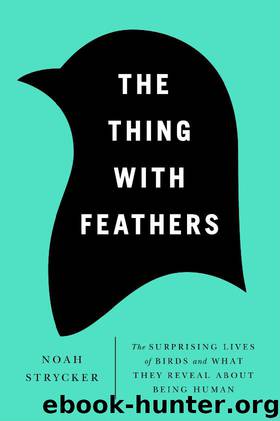The Thing With Feathers: The Surprising Lives of Birds and What They Reveal About Being Human by Noah K. Strycker

Author:Noah K. Strycker [Strycker, Noah K.]
Language: eng
Format: epub
Tags: Science
ISBN: 9781594486357
Google: 8kHZCwAAQBAJ
Goodreads: 18079702
Publisher: Riverhead Books
Published: 2014-03-20T07:00:00+00:00
seeing red
WHEN THE PECKING ORDER BREAKS DOWN
Let’s talk chicken.
By the end of the twentieth century, domestic chickens outnumbered humans by about four to one on this planet, distinguishing them as the most abundant bird species on earth. Actually, chickens are the world’s most numerous reptile, amphibian, mammal, or bird, period. At any given time, the globe hosts about 20 billion domestic chickens, though most don’t live very long. The average North American eats more than fifty pounds of chicken a year (the equivalent of about twenty-seven individual birds), which ranks, pound for pound, slightly less than beef and a bit more than pork.
Birdwatchers tend to denigrate chickens because domesticated species don’t qualify on official life lists. Unless you happen to prowl the tiger-infested jungles of India, where a few wild red junglefowl—the tropical ancestor of today’s McChicken—still flock together, you won’t get much credit for observing poultry. But we should pay attention to chickens, if for no other reason than their familiarity.
We can learn a lot about the world from farm fowl, as a six-year-old Norwegian boy demonstrated a hundred years ago.
—
THAT YOUNG BOY, tending his mother’s chicken coop outside of Oslo, noticed something curious about the birds he fed every morning. When any two hungry chickens met at the food tray, one would always make way for the other, patiently waiting its turn. Instead of fighting like unruly teenagers over Thanksgiving dinner, the chickens usually formed an orderly line with minimal fuss.
Furthermore, the order was utterly predictable. One particular hen was always the first to eat, followed by a second individual, then a third, and so on. At the water dish, their behavior was the same. If one tried to jump the line, it was barraged by pecks from the birds in front, and it quickly retreated.
By the time he was ten, Thorleif Schjelderup-Ebbe was keeping his observations in detailed notebooks. He’d discovered that the order of the feed line was based on aggression; certain hens, for some reason, always dominated others. So Schjelderup-Ebbe—let’s call him Thor—began charting aggressive interactions among the birds in his mother’s chicken coop, hoping to figure out, scientifically, whether his ideas made sense.
When Thor tallied up his observations, a pattern emerged. The top bird, at various times, had pecked every single one of the other chickens in the coop, but had never been pecked in return. In second place was another hen that had pecked everyone else except the top chicken, and, accordingly, had been pecked only by that bird. This trend continued down the line until only one poor hen was left standing—barely—which had been pecked by every other chicken in the coop but never delivered a single peck of its own. The alpha chicken always ate first, and the lowliest one always got the crumbs.
It took Thor many years to accumulate these observations because his flock seemed so comfortable with their order that they rarely acted aggressively toward one another. Each bird knew its place. The lower-ranked hens accepted their status and preferred not to challenge up; altogether, it was a fairly peaceful if unequal arrangement.
Download
This site does not store any files on its server. We only index and link to content provided by other sites. Please contact the content providers to delete copyright contents if any and email us, we'll remove relevant links or contents immediately.
Photographic Guide to the Birds of Indonesia by Strange Morten;(2469)
The Big Twitch by Sean Dooley(2369)
7-14 Days by Noah Waters(2298)
Tippi by Tippi Hedren(2156)
Identifying Birds by Colour by Norman Arlott(2148)
Birds of the Pacific Northwest by Shewey John; Blount Tim;(1906)
Raptors by Traer Scott(1557)
The Path Between the Seas by David McCullough(1548)
Bald Eagles In the Wild by Jeffrey Rich(1439)
Life on Earth by David Attenborough(1400)
Skin by Unknown(1345)
How to Speak Chicken by Melissa Caughey(1280)
Nest by Janine Burke(1235)
The Feather Thief by Kirk Wallace Johnson(1220)
Life List by Olivia Gentile(1147)
H Is for Hawk by Helen Macdonald(1141)
Birds of New York City by Cal Vornberger(1141)
RSPB Pocket Guide to British Birds by Simon Harrap(1119)
The Peregrine by J. A. Baker(1074)
